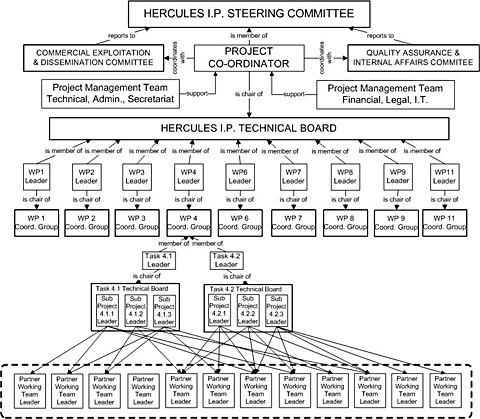 |
 |
Structure |
|
 |
|
The work is divided into: 1. RTD Activities
2. Demonstration Activities
3. Training Activities
4. Management Activities
----------------------------------------------------------------------
1. RTD Activities
The Research and Technological Development work is structured in nine (9) Workpackages, eighteen (18) Tasks and
Fifty-four (54) Subprojects.
|
| |
|
| |
|
| |
|
2. Demonstration Activities Full scale shipboard installations are foreseen in HERCULES in the
following Workpackages:
- Workpackage 4: Turbocompound engine/hot-engine:
Prototype components will be installed onboard a containership of Hapag Lloyd Container Linie GmbH.
The objective will be to demonstrate the increased overall efficiency of the
powerplant.
- Workpackage 6: Emission reduction methods (internal-water).
Water preparation and water engine injection systems will be installed onboard
ships of: A.P. Moller-Maersk A/S and Wallenius Marine AB. The objective will
also be to demonstrate the reduction in NOx emissions with the water injection
system.
- Workpackage 11: Adaptive engine
An electronically controlled camless engine is expected to be installed
onboard a newbuilt ship of Kristen Navigation Inc.
The objective will be to demonstrate the suitability for the purpose and
reliability of the "intelligent" control system.
3. Training Activities
Specialised Advanced Training Seminars will be organised in the final year of
the I.P. in three Areas of Marine Engine R&D:
- Experimental and Measurement methods (coordinator HUT)
- Computational Fluid Dynamics and Combustion (coordinator ETHZ)
- Process simulation (coordinator NTUA/LME)
4. Management Activities
The Central Management activities of the I.P. HERCULES will be undertaken by the Coordinating Partner (ULEME E.E.I.G.).
The overall objective will be to coordinate the I.P. and be responsible for
the technical / financial / administrative / legal management of the consortium.
The Coordinating Partner will be responsible for inter-project & external
communication links and as such will provide a gateway to the I.P. and a focal
point of all partners in the consortium. It will represent the HERCULES
consortium and act as an intermediary between the Consortium and the EC for all
information flow. It will sign the contract with EC and arrange countersigning
by all partners. It will prepare, review the Consortium Agreement (CA) and
arrange all partners to sign it. It will follow the partners?€™ technical progress
throughout the Project, coordinate all Work Packages and collect and submit
deliverables / reports. It will follow the partners?€™ costs and prepare
consolidated cost statements. It will collect audit certificates. It will
receive / administer / distribute part payments to partners and keep accounts of
accepted costs and work performed by each partner for each term and throughout
the Project period.
The hierarchical structure of the I.P. HERCULES management entities is shown graphically in the following figure:

|
| |
 |

